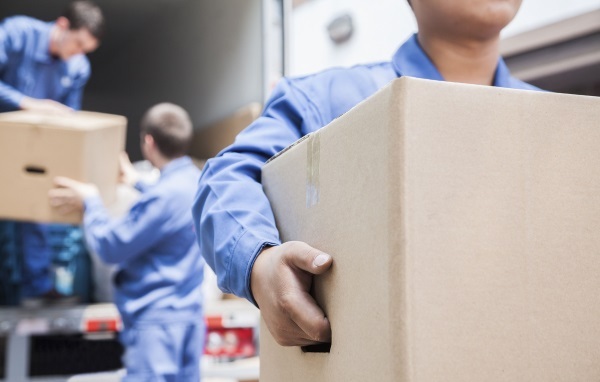If a person is faced with inflammation of the periosteum of the lower leg, then more often an exacerbation of symptoms occurs when running. These kinds of injuries are experienced by professional runners and those who have only recently started long races.
Such an injury is also called a shin splint. With her pain syndrome is localized in the area of junction of the tibia with the muscles of the lower leg. In difficult situations, tissue rupture can occur.
Record content:
- 1 The mechanism of injury to the periosteum
-
2 Inflammation causes
- 2.1 Excessive stress in training
- 2.2 Change of sport, track, shoes
- 2.3 Trauma or medical intervention
- 2.4 Osteomyelitis
- 2.5 Infections and other causes of damage
- 3 Varieties and symptoms of pathology
- 4 Who is more likely to encounter inflammation of the periosteum of the lower leg?
- 5 What makes the injury worse?
- 6 Diagnostics
-
7 Treatment during an exacerbation
- 7.1 NSAIDs
- 7.2 Compress with Dimexidum, Dexamethasone and Diclac gel
- 7.3 Cooling ointments
- 7.4 Cold compresses
- 7.5 Physiotherapy
-
8 Treatment during remission
- 8.1 Traditional methods
- 9 When can I return to training?
- 10 Video about inflammation of the periosteum
The mechanism of injury to the periosteum
Running differs from calm walking in that with it a person does not immediately lean on 2 legs at the same time, that is, one limb is always in the air. As a result, when it touches the ground, the weight of the body falls on the right or left leg. This provokes a sharp shock load.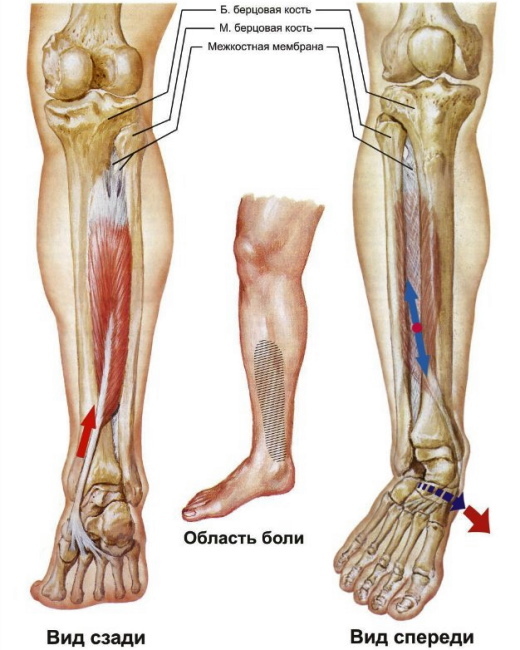
For her, the human body has to increase the tension of the stabilizing muscles of the foot. They are not responsible for power (like the calf muscle), but for creating an optimal position at the time of landing and pushing off the foot. Accordingly, due to this muscle, adaptation to an uneven surface occurs.
Due to the increased stress on the stabilizer muscles, they shorten (just like any other muscles after intense training). This activates the load balancing mechanism. When a person lands on one leg, its muscles, ligaments and bones take in and then dissipate the load.
If the muscle is in normal condition, then it absorbs most of the impact with its central part (abdomen). The rest of the load is on the tendons and attachments to the bones. If the muscles are shortened, then most of the load will fall on the tendons and attachments.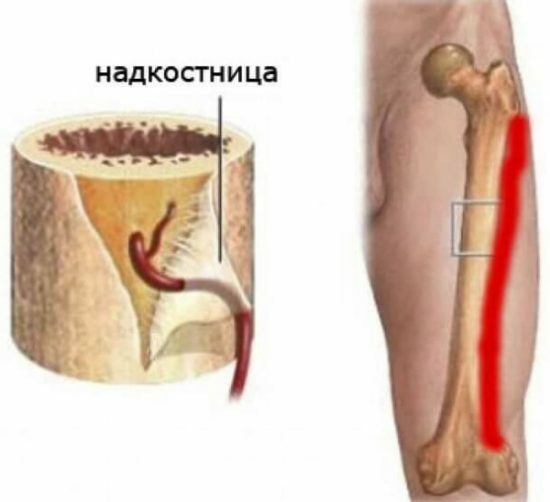
The stabilizing muscles themselves are not attached directly to the bones, but are woven into the periosteum. When a muscle takes a strong blow, it sharply pulls on the periosteum, which causes injuries and the development of inflammatory processes.
The shock load on the calf muscles can be increased due to structural disorders of the foot. For example, problems can arise from an excessively high arch of the foot.. This greatly reduces its cushioning capacity.
Inflammation causes
Inflammation of the periosteum of the lower leg while running can develop against the background of a variety of factors. In some cases, a person may even need serious treatment, up to and including surgery.
And sometimes it's enough to simply change the training regimen and choose more comfortable shoes.
Excessive stress in training
Most often, beginner athletes encounter this problem, who begin to give their best. Wanting to achieve quick results, they barely rest between workouts. If you go in for sports every day for 8-12 hours, then problems with the ankle will definitely appear.
Also, often with inflammation of the periosteum, those who are trying to get rid of excess weight in a short time by means of intensive training are faced.
Change of sport, track, shoes
Improperly fitted shoes can also cause inadequate load distribution.. Also, do not drastically change the type of exercise, especially if a person has been specializing in one kind of sport for a long time.
You need to run on an extremely flat, hard surface. If an athlete changes the track and starts running, for example, in the forest or on the beach, then this also leads to increased stress and severe pain syndrome.
Trauma or medical intervention
Problems may arise in the background:
- leg fracture;
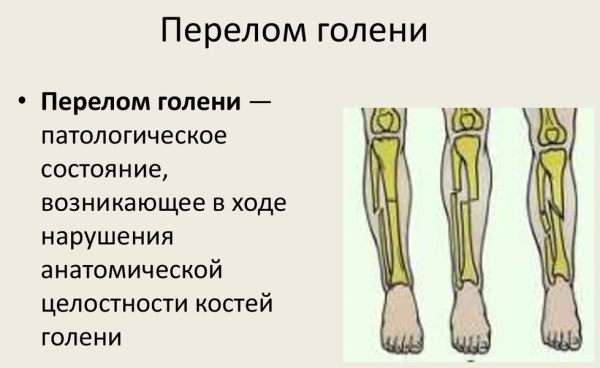
- hip injury;
- bruises of the lower extremities;
- stretching the muscles of the lower leg.
The injury could have been received for a long time. Also, those who have undergone limb treatment, including surgery, should be more careful in the choice of training.
Problems may appear against the background of intoxication after prolonged drug treatment. This affects the integrity of the bone fibers. As a rule, this happens due to self-medication.
Osteomyelitis
Against the background of this disease, necrosis of the bone marrow and adjacent tissues may develop.. This pathology is extremely dangerous, since with it, the patient's temperature rises to 40 °, severe pains appear. If the diagnosis is untimely, a fistula will form, which will significantly complicate the treatment and may require surgical intervention.
Infections and other causes of damage
Inflammation of the periosteum can be caused by:
-
Phlegmon. In this case, serious damage to the soft tissues located next to the periosteum is diagnosed. With phlegmon, there is a risk of so-called purulent spillage or inflammation of the cell space. The main danger lies in the fact that the disease develops very quickly, it can proceed with hyperthermia, increased weakness. Also, patients suffer from tachycardia, low blood pressure, inflammation in the lymph nodes.
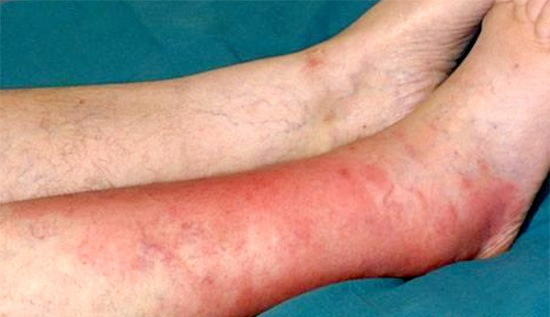
- Abscess, characterized by clear edges and localization. With this phenomenon, purulent foci are also formed. Patients complain of general weakness and aches in the summer. Many have trouble sleeping. Purulent exudate can penetrate into adjacent tissues.
- Sepsis. This condition belongs to the category of severe complications that are provoked by the entry of pathogens into the bloodstream. There is a risk of death if the infection spreads throughout the body. Therefore, timely diagnosis and treatment is required.
- Mediastinitis or acute periostitis. This process is characterized by the fact that the infection enters the mediastinum. This leads to severe shortness of breath, headaches and bouts of hyperthermia. There is a risk of death if the patient is not provided with an ambulance.
Inflammation of the periosteum can also be triggered by circulatory problems in the extremities.
Varieties and symptoms of pathology
Inflammation of the periosteum of the lower leg during running at an early stage is characterized by a slight pain syndrome, which is localized in the inner part of the lower leg. The most unpleasant sensations occur in the place where the gastrocnemius muscle borders on the lower leg.
The pain in this case mainly appears at the end of training or when pressing on the lower leg.
If the patient's condition can be characterized as neglected, then it manifests itself in the form:
- Aching pain. Also, during normal walking (not sports) and at rest, the patient may complain of a burning sensation.
- Pain that spreads throughout the lower leg and can radiate to the foot and thigh.
- Swelling and redness of the lower leg.
- Increased body temperature.
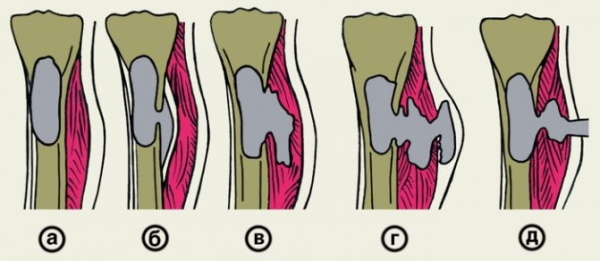
You can also classify the lesion, depending on its form of severity:
| Form | Peculiarities |
| Simple | In this case, the inflammatory process does not spread to the bone tissue or the bones themselves. In 97% of cases, a month after intensive treatment, a person fully recovers. |
| Purulent | Purulent formations appear in the tissues, and bone damage may develop. |
| Serous | Symptoms, it is identical to the purulent one. But in this case, the patients are diagnosed with the presence of racemose sacs filled with serous fluid. |
| Fibrous | Most dangerous form. Patients are diagnosed with bone lesions, purulent sacs, and fibrous thickenings. This form is characterized by a very high body temperature. |
Who is more likely to encounter inflammation of the periosteum of the lower leg?
Inflammation of the periosteum, which is most noticeable in the lower leg, according to doctors, most often develops in runners. More than 95% of patients are athletes.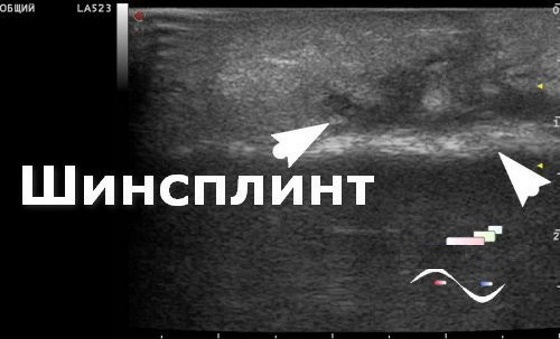
Cyclists, football players, hockey players, as well as weightlifters also suffer from this type of inflammation. This category includes all people who prefer hard training, which includes strong loads on the lower extremities. Also, people who are overweight are faced with similar problems.
What makes the injury worse?
The condition may be aggravated by the fact that the patient does not interrupt training when pain occurs. Same
Diagnostics
It is possible to quickly diagnose this pathology only if the patient described in detail under what conditions the symptoms began to appear, and also describes them in detail. After the initial examination and interview with a therapist, it is worth contacting a traumatologist, orthopedist and surgeon. Specialists will prescribe the appropriate tests.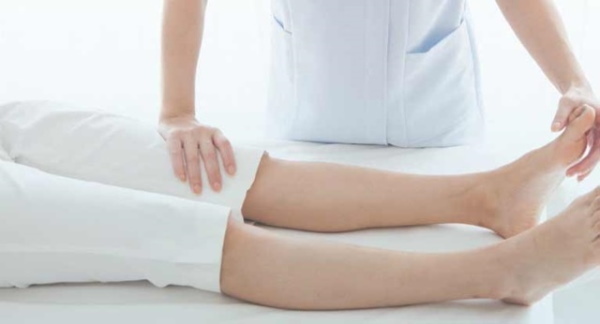
The most effective diagnostic method is considered to be ultrasound and X-ray.. This will allow you to accurately understand the reasons that caused the inflammation of the periosteum, as well as the lower leg.
Treatment during an exacerbation
After diagnosis, the doctor most often prescribes a comprehensive treatment. It can include potent drugs, IVs, and physical therapy. Traditional medicine is allowed, but only after consultation with a specialist.
If we are talking about a period of exacerbation, then you need to visit a sports doctor or orthopedist-traumatologist.
As a rule, the specialist recommends:
- Reduce or completely eliminate running loads. If a person goes in for sports professionally, then during this time he can increase cyclic loads (unstressed type) in order to keep himself in good shape. Swimming and cycling are also recommended.
- Start taking non-steroidal anti-inflammatory drugs like Nise.
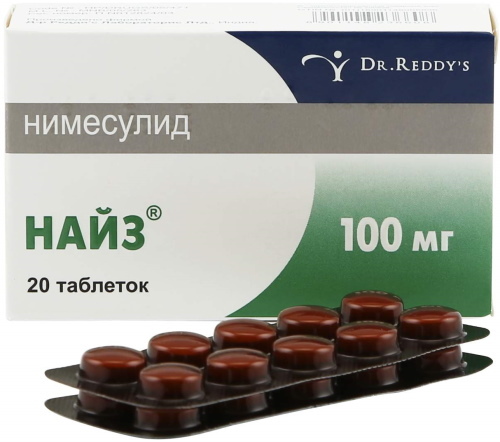
Nise will help relieve pain in case of inflammation of the periosteum of the lower leg when running - Use local compresses with Dimexide and Diklak.
- Conduct cooling procedures.
When returning to stress, it is recommended to wear compression gaiters and use an elastic bandage to support the calf muscles. If during training a person begins to experience pain, then he must immediately stop them.
NSAIDs
Non-steroidal anti-inflammatory drugs have a quick effect and can reduce pain and inflammation. The doctor may prescribe different drugs, but most often experts prescribe Nise. This drug is well absorbed from the gastrointestinal tract.
Inflammation of the periosteum of the lower leg while running can be relieved with these tablets. It is recommended to take them in a very short course, with plenty of water. Adults are recommended 1 tab. twice a day. This drug is not recommended for children under the age of 12. If the patient has gastrointestinal diseases, then the drug should be taken after a meal.
Patients diagnosed with renal failure should reduce the dosage to 1 tablet per day. Since Nise has a large number of contraindications, it can only be taken as directed by a doctor. Also drugs Nurofen and Ibuprofen belong to the category of NSAIDs.
Compress with Dimexidum, Dexamethasone and Diclac gel
Compresses are suitable for local use. For example, you can rub in Dimexide gel, 1 ampoule of Dexamethasone and Diclac gel daily for 20 minutes.
The course of treatment using such funds is no more than 3-5 days. Topical preparations help relieve swelling and relieve inflammation. Also, gels have an analgesic effect.
Cooling ointments
Thanks to the means of this type, vasoconstriction occurs, which can significantly reduce hematoma and swelling. Cooling ointments contain menthol, essential oils, and pain relievers. You cannot rub in such compositions. Ointments are applied with light movements. At first, the patient feels a little cold in the treated area, and then relief comes.
Of the most effective means of this type, it is worth highlighting:
-
Troxevasin. The main component of the ointment is troxerutin. This substance has an effective effect on blood vessels, helps to restore the walls of capillaries, and relieves the inflammatory process. Thanks to troxerutin, metabolic processes occurring in cells are accelerated, damaged tissues regenerate faster. After applying the ointment, slight numbness is observed, which is the norm.
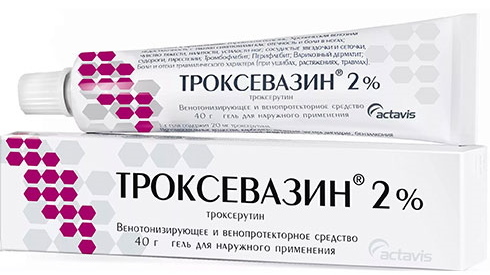
- Lidocaine. It is recommended to apply an ointment with this active ingredient 3-4 times a day. The remedy is contraindicated in people who suffer from renal failure or allergy to the active substance.
- Dimexide. Relieves pain and inflammation. In addition, Dimexide accelerates the healing of damaged tissues. It is necessary to apply a very small amount of such an ointment to the skin. Since the main substance of the agent belongs to the category of poisonous, then Dimexide can be used no more than 3 times a day.
Cold compresses
Compresses of this type can be used locally, in the area where pain occurs.
For the procedure:
- You need to put frozen vegetables or just ice in a plastic bag.
- After that, you need to wrap the bag in cotton cloth, possibly in several layers.
- It is necessary to keep such a compress no more than 10 minutes in 2-3 approaches.
Such procedures must be performed very carefully, as there is a risk of aggravating the situation. This is not a method of treatment, but only a method to temporarily relieve swelling and severe pain.
Physiotherapy
As methods of physiotherapy for such problems, they use:
- hydromassage bathrooms;
- phonophoresis;
- electrical stimulation and much more.
Such measures are effective both in exacerbation and in the normal course of the inflammatory process.
However, physical therapy is usually used as one of the comprehensive treatment methods. The greatest efficiency from the procedures will be if the patient takes the necessary medications at the same time.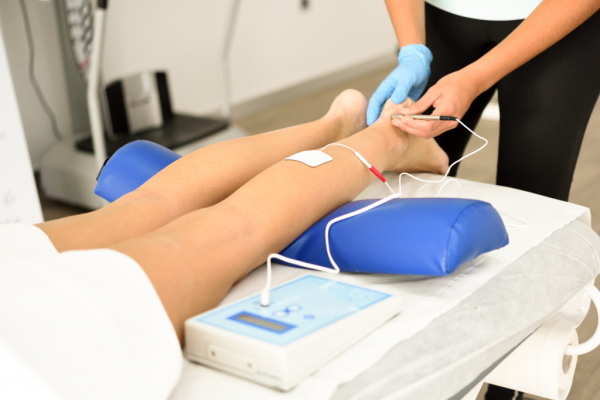
If the patient returns to active training, then in addition to more gentle sports exercises, it is recommended:
- Increase cadence while running. You need to perform no more than 180 steps per minute. This will reduce shock loads.
- Prefer shoes with more cushioning.
- Use corrective bandages and other supportive products, which are usually used for overpronation of the foot or in the case of flat feet.
- Exercise to strengthen the lower leg.
Physiotherapy procedures are prescribed for a period of 2 weeks to 2-3 months.
Treatment during remission
Inflammation of the periosteum of the lower leg while running can be cured. But even during the period of remission, you need to be very careful. If alarming symptoms occur, supportive therapy should be preferred. For example, in such a situation, you can use the methods of traditional medicine.
Traditional methods
Even in the case of remission, treatment with alternative methods is recommended to be combined with taking medications or physiotherapy procedures.
Among the most effective methods of alternative treatment, it is worth highlighting:
- Chamomile compresses. Prepared on the basis of a decoction of chamomile, in which it is necessary to moisten a cotton pad. It should be applied to the sore spot 3-4 times a day.
-
Sage tea. To prepare it, you need to pour 15 g of dry sage with 150 ml of boiling water. Immediately after this, the liquid must be covered with a lid and left for 30 minutes. Further, you need to strain the infusion and drink it 25 ml daily, 2 times. Such a remedy will quickly reduce inflammation.
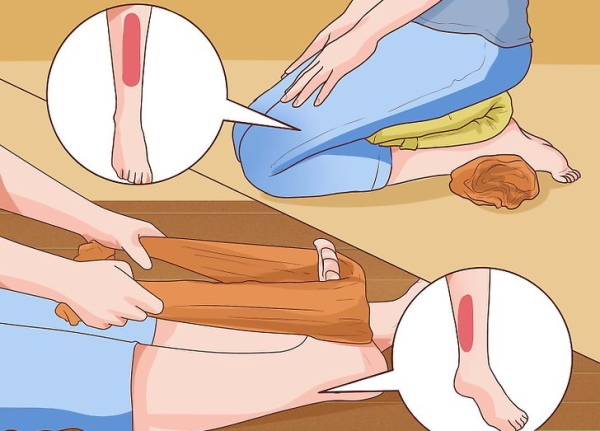
Stretching exercises for the muscles of the lower leg give a positive effect. - Comfrey ointment. This plant has a regenerating effect, reduces inflammation. To prepare the ointment, you need to melt 100 g of butter in a steam bath. After that, powdered comfrey root (100 g) is added to it. The resulting mixture must be thoroughly stirred and heated in a water bath for half an hour. After that, the agent needs to be cooled and applied to the inflamed area as needed. It is best to store this ointment in the refrigerator.
- Rubbing with adam root. This warming procedure will help with exacerbations. To prepare the product, you need to grind 200 g of Adam's root and fill it with 2 glasses of vodka. The infusion must be kept in a dark place for 5 days. After that, the product must be rubbed into the affected area and covered with a knitted cloth.
It should be borne in mind that if we are talking not only about pain, but also about severe inflammation (for example, purulent), then any warming up procedures can be dangerous, as they will only accelerate the spread of pus to neighboring fabrics.
When can I return to training?
You can return to active training if the limb has become as mobile as the healthy leg, you can safely step on it. In this case, the patient should not experience any pain. It is also worth trying a few jumps in place and a short run. If there is no discomfort during such exercises, then you can return to training.
It is impossible to name exactly the time when the inflammation of the periosteum of the lower leg will pass. Sometimes, patients continue to experience some discomfort when running even 3-6 months after undergoing treatment. It often takes 3-4 weeks to fully recover. It all depends on the individual, as well as on the degree of damage. Only a doctor can name the approximate recovery time.
Video about inflammation of the periosteum
Pain in the periosteum - what to do, how not to harm:



